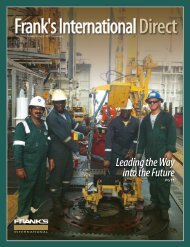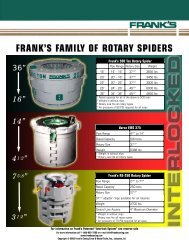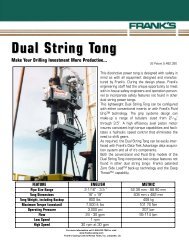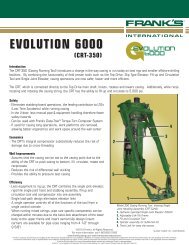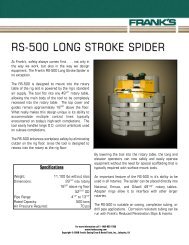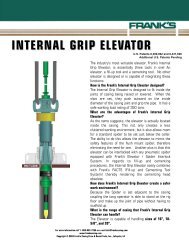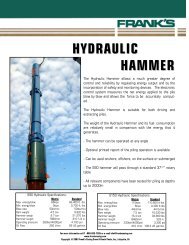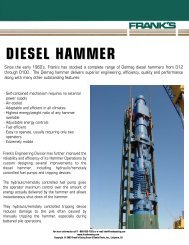Master Mag Templet - Frank's International, Inc.
Master Mag Templet - Frank's International, Inc.
Master Mag Templet - Frank's International, Inc.
You also want an ePaper? Increase the reach of your titles
YUMPU automatically turns print PDFs into web optimized ePapers that Google loves.
Imagine traveling through the air,<br />
high above civilization. The peace,<br />
tranquility, and scenery you experience<br />
riding in a hot-air balloon is<br />
beyond words.<br />
It is not surprising that hot-air ballooning<br />
has retained its popularity for more<br />
than 200 years.<br />
Maiden Voyage<br />
On a hot and balmy day in 1783, a<br />
sheep, a duck, and a rooster became the<br />
first passengers in a hot air balloon<br />
launched by the Montgolfier brothers,<br />
Joseph and Etienne.<br />
The brothers, wealthy paper-makers<br />
from Annonay, France, sent their farm<br />
friends on an eight-minute ride in a<br />
paper-lined balloon 6,000 feet in the<br />
air, celebrating the first practical launch<br />
of a hot-air balloon.<br />
Today, hot-air ballooning has become a<br />
favorite pastime among tourists who<br />
26<br />
find balloon travel an incredible way to<br />
view exotic locales around the world.<br />
The Rest Is History<br />
Through the years, hot-air balloons<br />
have served as more than just tourist<br />
diversions. During the Franco-Prussian<br />
War of 1870-1871, balloons were used<br />
for military observation by the armies<br />
of both nations. In World War I, armed<br />
forces made extensive use of balloons<br />
to observe enemy lines. And during<br />
World War II, the British army used the<br />
barrage balloon, a large fabric balloon<br />
tethered to a steel cable, to protect<br />
London from low-level air attacks.<br />
Early hot-air balloon sales were made<br />
exclusively for the government for use<br />
in military and research applications,<br />
but in the 1960s, several companies<br />
began purchasing the balloons for<br />
recreation and sport. On October 10,<br />
1960, the first man-carrying free flight<br />
took place in Bruning, Nebraska, in the<br />
Raven Industries prototype of a modern<br />
hot-air balloon. Now constructed of a<br />
polyurethane-coated nylon and powered<br />
by propane, the balloon has evolved significantly<br />
over the years.<br />
Early hot-air balloon sales<br />
were made exclusively for the<br />
government for use in military<br />
and research applications.<br />
Balloons consist of a large, flexible<br />
bag containing either hot air or gas<br />
that is lighter than air. The bag, known<br />
as the envelope, is made of varnished<br />
silk, rubber, or other suitable materials.<br />
Piloted balloons carry passengers in a<br />
suspended gondola, or basket, while<br />
unpiloted balloons are typically used<br />
for research purposes.<br />
After 1960, the fledgling Raven<br />
Industries, formed by a small group of<br />
continues on page 28



